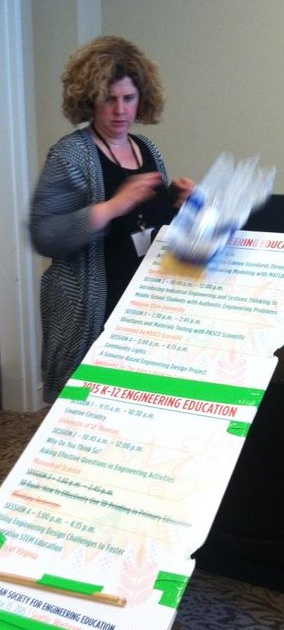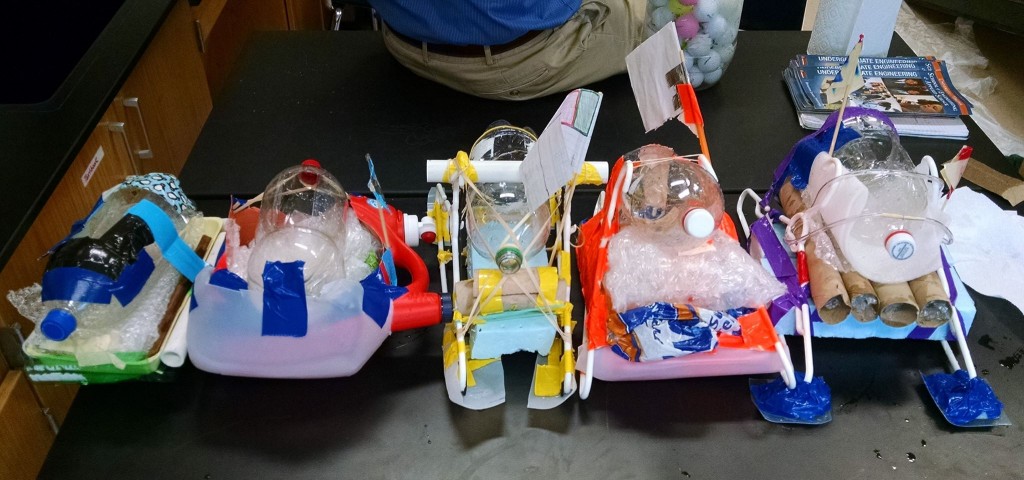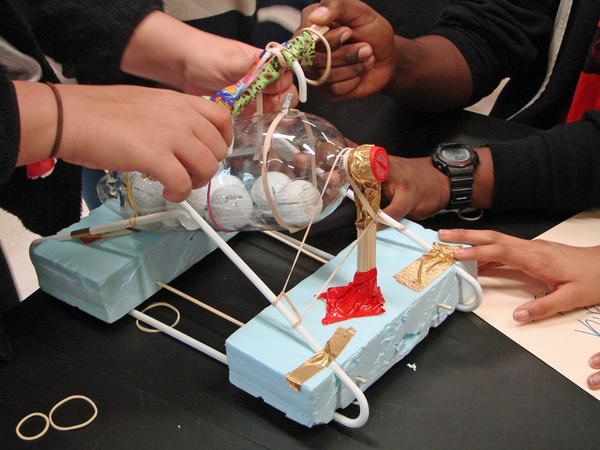Trash Sliders
Activity developed by Larry Richards, University of Virginia mechanical and aerospace engineering professor, who conducted it with teachers at the 2015 ASEE K-12 Workshop in Seattle. It is among the Engineering Teaching Kits he created for the School of Engineering and Applied Science’s K-12 outreach program.
Summary
In this activity, teams of middle school students express their creativity while learning the fundamentals of engineering design, sustainability, suspension systems, and the basic physics of forces and motion by building a vehicle out of recycled trash that is capable of transporting liquid over rough terrain with as little spillage as possible.
Note: This activity can be scaled for high school as well as upper elementary students.
Grade level: 6 – 8
Time: 75 – 90 minutes
Learning objectives:
After doing this activity, students should be able to:
- Understand how static and kinetic friction are important concepts in engineering design.
- Apply their knowledge of friction, drag, mass, and gravity to the design of their sliders
- Demonstrate their knowledge of potential and kinetic energy
- Experience the engineering design process
- Recognize that different materials and surfaces have different frictional coefficients.
- Understand the link between recycling and sustainability
- Develop new uses for discarded trash
International Technology and Engineering Educators Association
Energy is the capacity to do work. [Grades 6 – 8]
Next Generation Science Standards
- Develop a model to describe that when the arrangement of objects interacting at a distance changes, different amounts of potential energy are stored in the system [Grades 6-8]
- Construct, use, and present arguments to support the claim that when the motion energy of an object changes, energy is transferred to or from the object. [Grades 6-8]
- Evaluate competing design solutions using a systematic process to determine how well they meet the criteria and constraints of the problem.
Engineering Connection
Engineers work in teams to come up with designs through an iterative process that involves prototyping, testing, identifying and fixing flaws, and retesting until the design works. The process also must be done within such constraints as time, cost, and appropriateness of materials.
The Challenge
Design a slider out of trash that can race down an incline as quickly as possible while spilling the least amount of water.
Materials
For each team:
One empty 2-liter plastic bottle with a rectangular opening cut in the side. (This will be the top of the vehicle’s body.)
For the group:
- Tape
- Rubber bands
- Measuring cup (to measure 500 milliliters of water into each vehicle)
- Assorted trash or recycled items, such as plastic water bottles, packing materials, bubble wrap, cloth, paper, coat hangars, cotton balls, golf balls, rubber, washers, etc.
Process
Before the challenge.
- Build the race course. The ramp should include bumps or other rough terrain, but can also be made from cardboard posters taped together and propped up against a table or lectern, as demonstrated at the ASEE K-12 Workshop in 2015 (photo, above right). The ramp the University of Virginia engineering outreach program uses starts with a bumpy plastic kids’ slide, followed by wooden plywood panels with speed bumps across them. Watch videos of a successful and not so successful trial run!
With the students
2. Introduce the challenge. Teams will construct small vehicles from recycled materials that they either will release at the top of the ramp or push along down a series of slides. The body of each vehicle has a rectangular cut in its top, through which 50 milliliters of water will be poured at the start of the trial. The goal: Race (or be propelled ) down the ramp and spill as little water as possible.
3. Planning. Ask students to explore the available materials, seeing which are the heaviest or lightest. Which materials slide well across the table? Have them test some of the sample materials to see how they perform and brainstorm different combinations for their sliders. Discuss the tradeoffs between speed, steadiness, and ability to hold water without tilting or tipping over, then pick an idea to design and test. How will they suspend the water-filled vehicle to reduce splashes and spills?
4.Create. Ask teams to determine which materials to use and construct their designs. Will they change the surface material or the weight? How will they attach all of the components?
5. Test. Teachers and volunteers might want to help teams test their designs. Ask them to try changing just one thing on their design and testing again.
6. Improve. Which design worked best? What did you learn from your tests? How could you make an even faster or sturdier slider?
Activity Extensions
- Change the angle and length of the track. Investigate the results of increasing potential energy (length and height of hill). How does it effect the acceleration and velocity of the trash slider?
- Restrict the choice of materials. How does that affect performance?
- Add or reconfigure speed bumps or other obstacles.

Trash sliders made by high school students at the University of Virginia School of Engineering and Applied Science’s BLAST camp.
Additional Resources
Engineering Teaching Kits. Founded by University of Virginia mechanical and aerospace engineering professor Larry Richards throughthe Virginia Middle School Engineering Education Initiative, these resources allow undergraduates and teachers to customize science lessons using engineering design. Engineers Way is U. Va.’s Facebook page for School of Engineering and Applied Sciences’ K-12 outreach program.
Middle School Students Learn Engineering Principles. Charlottesville Tomorrow article (3/30/15) about a week-long Trash Sliders engineering design project taught by University of Virginia undergraduate engineering students. (Photo, above)
Movin’ Along: Investigating Motion and Mechanisms Using Engineering Design Activities. Frontiers in Engineering 2015 research paper by the University of Virginia engineering educators Susan K. Donahue and Larry Richards on teaching physics and other science concepts through engineering design activities such as Trash Sliders.
Watch trash sliders in action at U.Va’s BLAST camp, as reported on NewsPlex.com.
Filed under: Class Activities, Grades 6-8, Grades 6-8, Lesson Plans
Tags: Class Activities, creativity, Earth Day, Engineering Design, Environmental Engineering, forces and motion, Grades 6-8, Lesson Plan, Recycling, STEAM, Sustainability, Trash








